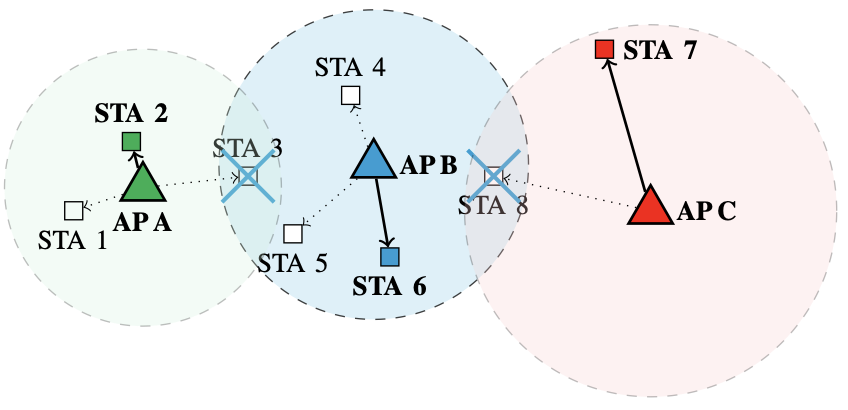News and Announcements

Guest Lecture: Artificial Intelligence and the Internet of Bio-Nano-Things
July 10, 2025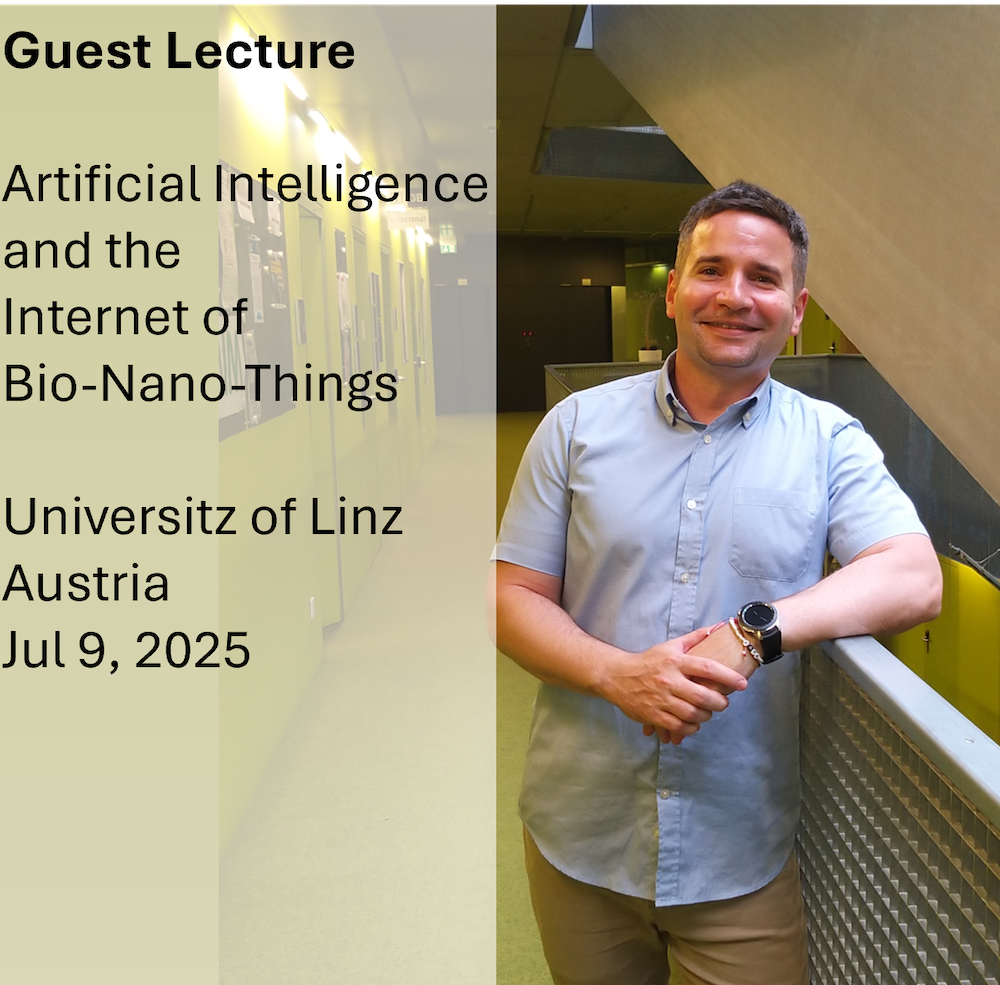
Our team member Jorge Torres Gómez gave a lecture on the joint topic of AI and the Internet of Bio-Nano-Things (IoBNT). The lecture took place at the University of Linz with researchers from the Institute of Communications Engineering and RF-Systems. The lecture overviewed the recent trends on neural networks for the IoBNT with a focus on the synthesis of neural networks in the molecular domain.New Elsevier Computer Communications article
July 10, 2025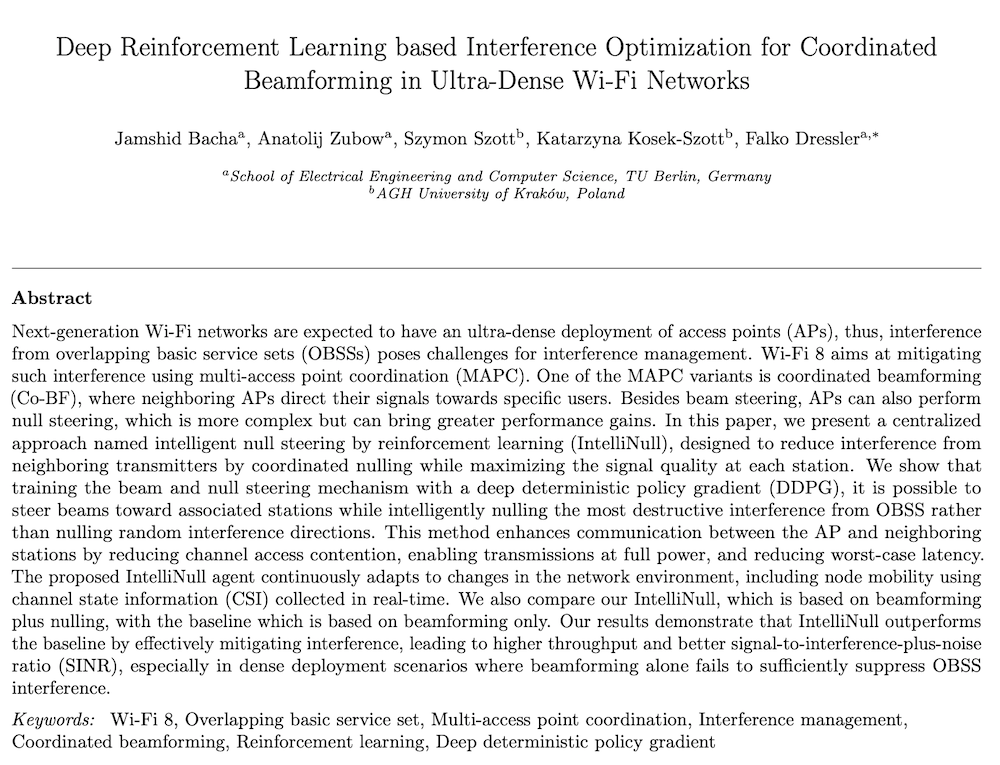
Our article Deep Reinforcement Learning based Interference Optimization for Coordinated Beamforming in Ultra-Dense Wi-Fi Networks has been accepted for publication in Elsevier Computer Communications. Next-generation Wi-Fi networks are expected to have an ultra-dense deployment of access points (APs), thus, interference from overlapping basic service sets (OBSSs) poses challenges for interference management. Wi-Fi 8 aims at mitigating such interference using multi-access point coordination (MAPC). One of the MAPC variants is coordinated beamforming (Co-BF), where neighboring APs direct their signals towards specific users. Besides beam steering, APs can also perform null steering, which is more complex but can bring greater performance gains. In this paper, we present a centralized approach named intelligent null steering by reinforcement learning (IntelliNull), designed to reduce interference from neighboring transmitters by coordinated nulling while maximizing the signal quality at each station. We show that training the beam and null steering mechanism with a deep deterministic policy gradient (DDPG), it is possible to steer beams toward associated stations while intelligently nulling the most destructive interference from OBSS rather than nulling random interference directions. This method enhances communication between the AP and neighboring stations by reducing channel access contention, enabling transmissions at full power, and reducing worst-case latency. The proposed IntelliNull agent continuously adapts to changes in the network environment, including node mobility using channel state information (CSI) collected in real-time.
(link to more information)TKN team at Berlin 6G Conference
July 02, 2025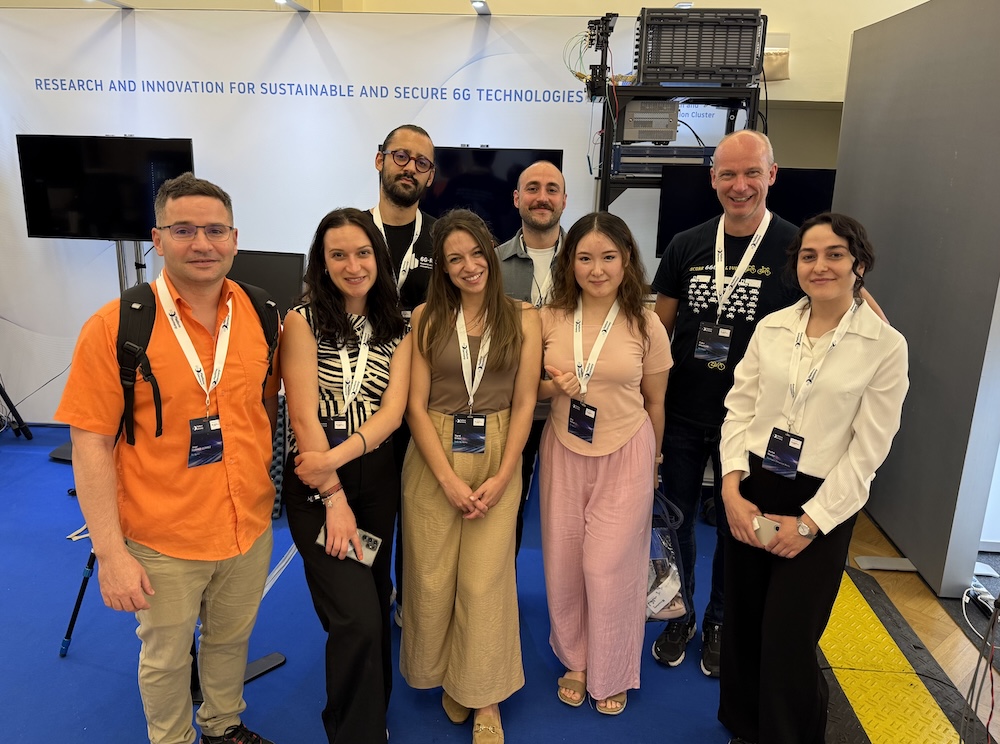
The TKN team joined the Berlin 6G Conference to discuss research results and new ideas related to 6G and beyond. The picture shows our team in front our booth as part of the 6G-RIC project.New DFG project SmartSynch
June 20, 2025
Our proposal Synchronizing in the nanoscale: A research project to enable communication networks in molecular communication channels (SmartSynch) has been accepted for funding by the German research foundation DFG. In this project, we will develop robust synchronization mechanisms for nanodevices in the dynamic blood flow environment. Our objectives include devising a realistic model for the transmission-reception scheme in human vessels, optimizing reported synchronization mechanisms in the literature for this particular environment, and designing a methodology to evaluate the preamble sequence and the data packet length.
(link to more information)New IEEE Transactions on Mobile Computing article
June 16, 2025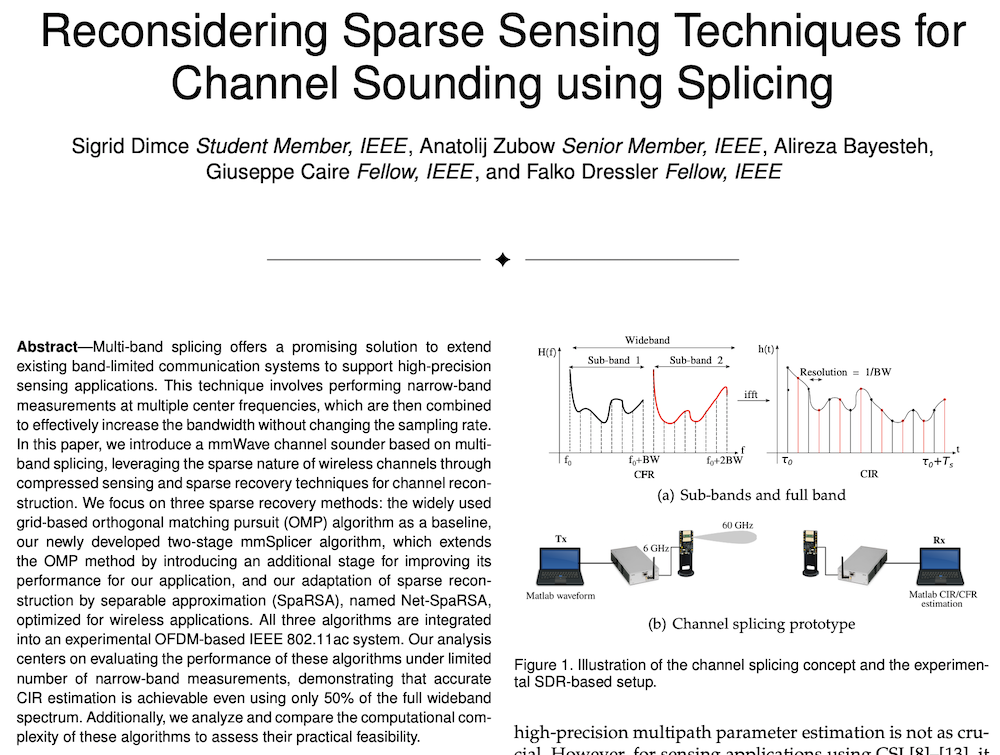
Our article Reconsidering Sparse Sensing Techniques for Channel Sounding using Splicing has been accepted for publication in IEEE Transactions on Mobile Computing. Multi-band splicing offers a promising solution to extend existing band-limited communication systems to support high-precision sensing applications. This technique involves performing narrow-band measurements at multiple center frequencies, which are then combined to effectively increase the bandwidth without changing the sampling rate. In this paper, we introduce a mmWave channel sounder based on multi-band splicing, leveraging the sparse nature of wireless channels through compressed sensing and sparse recovery techniques for channel reconstruction. We focus on three sparse recovery methods: the widely used grid-based orthogonal matching pursuit (OMP) algorithm as a baseline, our newly developed two-stage mmSplicer algorithm, which extends the OMP method by introducing an additional stage for improving its performance for our application, and our adaptation of sparse reconstruction by separable approximation (SpaRSA), named Net-SpaRSA, optimized for wireless applications.
(link to more information)New IEEE Transactions on Wireless Communications article
June 15, 2025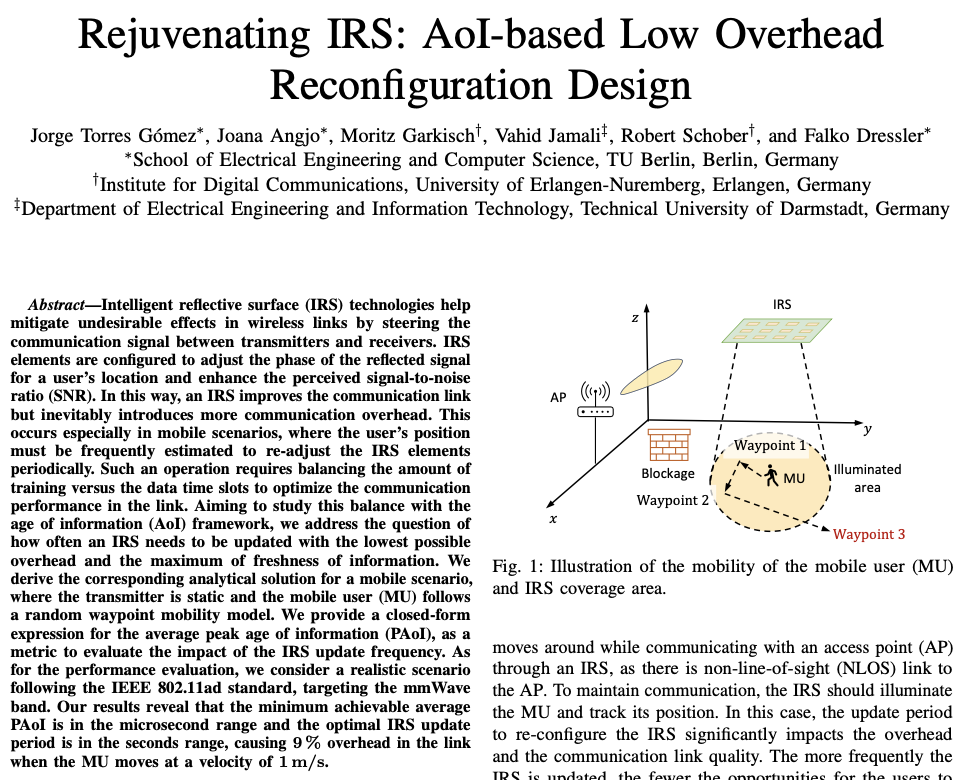
Our article Rejuvenating IRS: AoI-based Low Overhead Reconfiguration Design has been accepted for publication in IEEE Transactions on Wireless Communications. Intelligent reflective surface (IRS) technologies help mitigate undesirable effects in wireless links by steering the communication signal between transmitters and receivers. An IRS improves the communication link but inevitably introduces more communication overhead. This occurs especially in mobile scenarios, where the user's position must be frequently estimated to re-adjust the IRS elements periodically. Such an operation requires balancing the amount of training versus the data time slots to optimize the communication performance in the link. Aiming to study this balance with the age of information (AoI) framework, we address the question of how often an IRS needs to be updated with the lowest possible overhead and the maximum of freshness of information. We derive the corresponding analytical solution for a mobile scenario, where the transmitter is static and the mobile user (MU) follows a random waypoint mobility model. We provide a closed-form expression for the average peak age of information (PAoI), as a metric to evaluate the impact of the IRS update frequency.
(link to more information)New IEEE Open Journal of Intelligent Transportation Systems article
June 13, 2025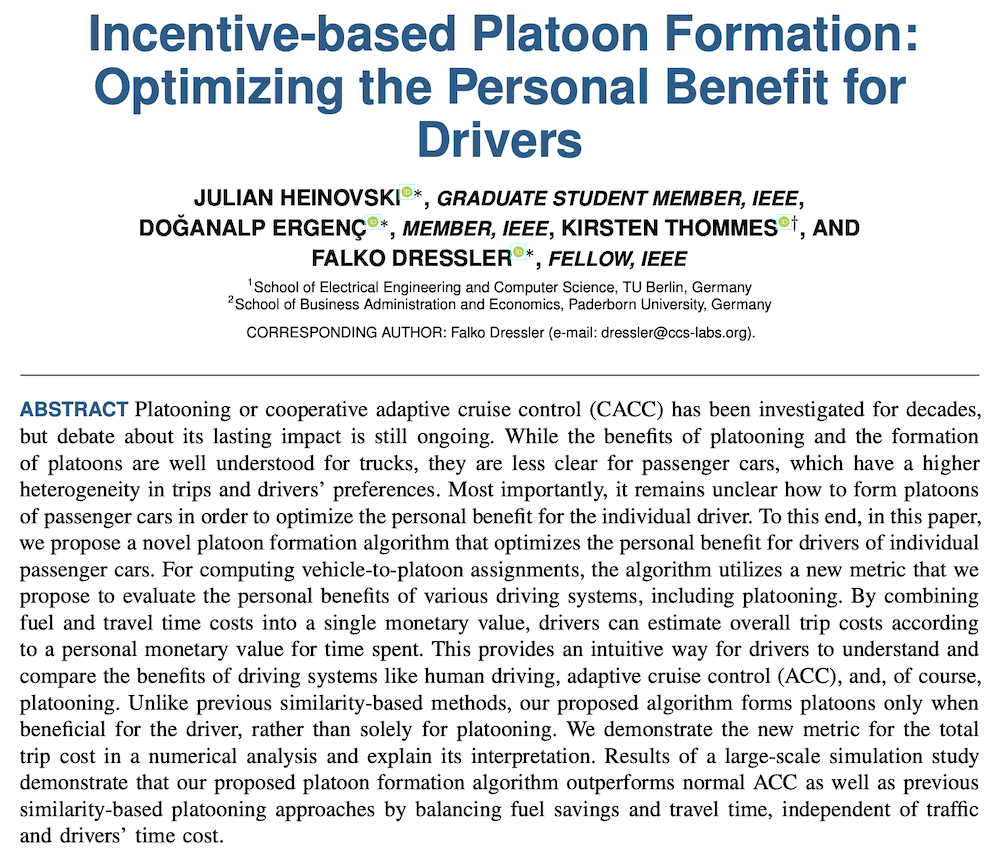
Our article Incentive-based Platoon Formation: Optimizing the Personal Benefit for Drivers has been accepted for publication in IEEE Open Journal of Intelligent Transportation Systems. In this paper, we propose a novel platoon formation algorithm that optimizes the personal benefit for drivers of individual passenger cars. For computing vehicle-to-platoon assignments, the algorithm utilizes a new metric that we propose to evaluate the personal benefits of various driving systems, including platooning. By combining fuel and travel time costs into a single monetary value, drivers can estimate overall trip costs according to a personal monetary value for time spent. This provides an intuitive way for drivers to understand and compare the benefits of driving systems like human driving, adaptive cruise control (ACC), and, of course, platooning. Unlike previous similarity-based methods, our proposed algorithm forms platoons only when beneficial for the driver, rather than solely for platooning.
(link to more information)Paper Presentation at IEEE ICC 2025
June 11, 2025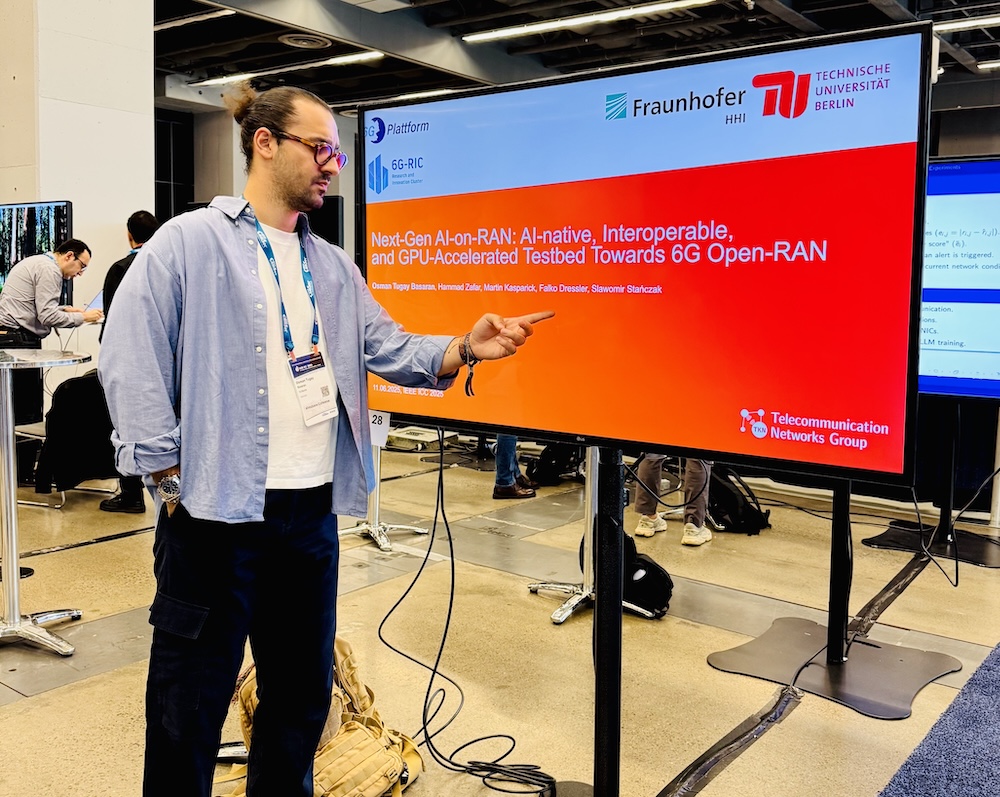
Osman Tugay Başaran presented our paper Next-Gen AI-on-RAN: AI-native, Interoperable, and GPU-Accelerated Testbed Towards 6G Open-RAN at the IEEE International Conference on Communications (ICC 2025), Montréal, Canada. Our recent work addresses a critical challenge in the journey from 5G to AI-native 6G: how to meet stringent latency and performance demands in O-RAN networks while simultaneously executing AI/ML workloads. We leverage the power of NVIDIA Aerial RAN CoLab (ARC) and the Aerial SDK to offload complex L1 and L2 signal processing onto GPUs. This not only slashes computational overhead but also opens the door to near real-time inferencing—essential for latency-sensitive 6G applications. A novel aspect of our approach is co-locating training and inference on the same NVIDIA GPU-accelerated platform.New Elsevier Theoretical Computer Science article
June 10, 2025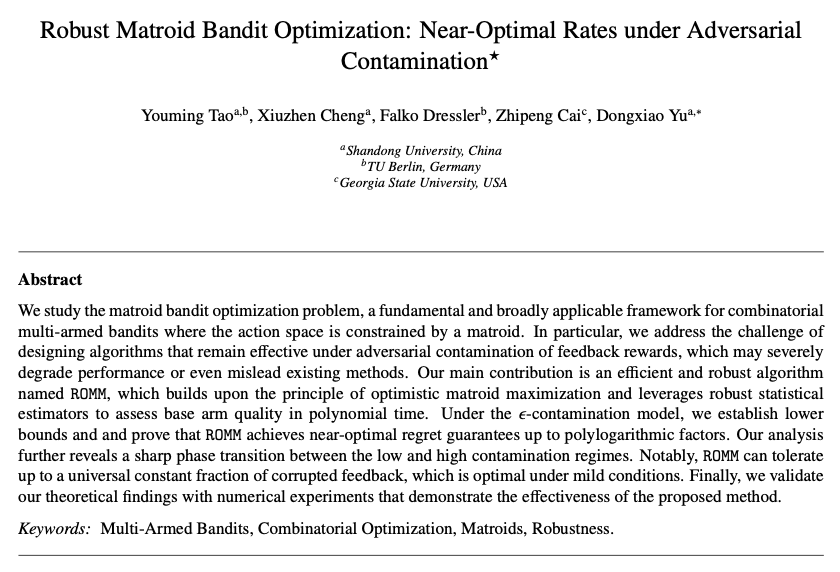
Our article Robust Matroid Bandit Optimization: Near-Optimal Rates under Adversarial Contamination has been accepted for publication in Elsevier Theoretical Computer Science. We study the matroid bandit optimization problem, a fundamental and broadly applicable framework for combinatorial multi-armed bandits where the action space is constrained by a matroid. In particular, we address the challenge of designing algorithms that remain effective under adversarial contamination of feedback rewards, which may severely degrade performance or even mislead existing methods. Our main contribution is an efficient and robust algorithm named ROMM, which builds upon the principle of optimistic matroid maximization and leverages robust statistical estimators to assess base arm quality in polynomial time.
(link to more information)Paper Presentation at IEEE TIHL 2025
June 08, 2025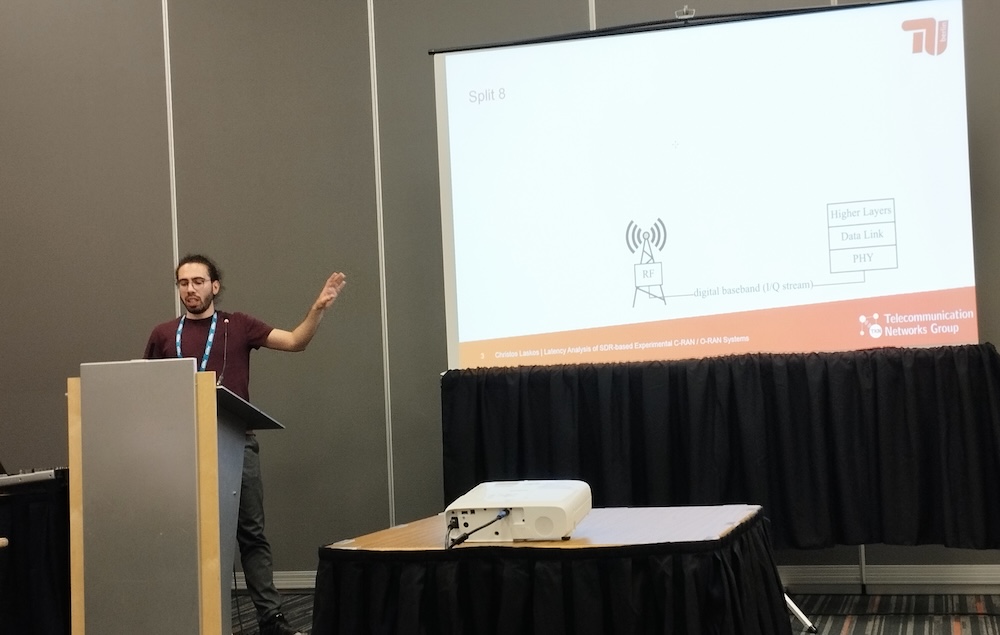
Christos Laskos presented our paper Latency Analysis of SDR-based Experimental C-RAN / O-RAN Systems at the IEEE ICC Workshop on Tactile Internet with Human-in-the-Loop (TIHL 2025), Montréal, Canada. In this paper, we present results from an extensive experimental evaluation of latency in commonly used SDR platforms, including USRP B210, N210, N310, and X410. For this, we implemented a novel round trip time (RTT) measurement method at the SDR driver level for precise RTT analysis. Our findings highlight the impact of SDR hardware, the connection to the host computer, sampling rates, and protocol optimizations. While all tested SDRs meet the latency requirements for 4G/5G-based C-RAN implementations (less than 500 µs), some approach the 25 µs one-way O-RAN delay, and none currently satisfy the more stringent 9 µs requirements of WiFi. We identify key optimizations, such as reducing the maximum transmission unit used in the fronthaul link layer and leveraging data plane development kit (DPDK) for low-latency networking, that significantly improves the SDR performance. Our results show that, in an optimal setup using X410 USRP, 100Gbe Ethernet fronthaul, DPDK, and optimal maximum transmission unit (MTU) size, the worst-case RTT stays below 65 µs.
Load all older news
Last modified: 2024-04-28

